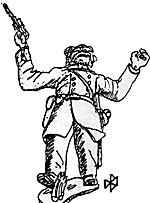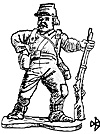 The Shenandoah campaigns reported on in previous issues of the Lone Warrior all played themselves out in the last few months, although each game reached its own unique conclusion.
The Shenandoah campaigns reported on in previous issues of the Lone Warrior all played themselves out in the last few months, although each game reached its own unique conclusion.
The newest game ended first. It only lasted seven campaign days, but the Confederates took such a decisive edge the Northern players conceded. The Confederate plan was a good one. It created a classic double envelopment on the campaign map, with the Rebel center weakly held, while larger forces on either flank took on the Union forces there. The campaign featured a key battle on each of the flanks and both tabletop fights were won by the Confederates. With their right and left pushed back and their center in danger of being surrounded unless it withdrew, the Northern players threw in the towel. They still had other options left, but the handwriting was on the wall. Rather than fight a long and wearing defensive campaign and with their immediate hopes of putting the Confederates on the defensive dashed, the Union players called it quits.
That game was the one I was administering for a wargaming group. There were two or three players on each side and the players themselves gamed out the battles. That's different from the standard Shenandoah PBM, in which the game is played by a single gamer on each side who sends in orders for each turn (campaign day), while I game out any resulting battles -- though the battles are based on plans by the players if the player's character, the army commander, is involved in the resulting battle.
A second campaign ended in a fizzle. In this one, the two players had been maneuvering and had never engaged in a pitched battle, even though the game had entered campaign day 14 (out of a maximum of 30). There had been a series of cavalry scouting contacts, some of which had ended disastrously. Properly used, cavalry units are able to determine what enemy units are where, necessary information for the opposing commanders. But throwing those scouting units forward into the unknown exposes them to risks and it's not unusual for a cavalry battalion or regiment to find itself cut off and surrounded by enemy horsemen. In such cases, the trapped unit might be able to cut its way to safety, or it might be forced to surrender by superior force. In this game, the Confederates had suffered the loss of one cavalry regiment in just that way. The commander-player announced a memorial service for his lost unit and pressed ahead. But, when the same thing happened to the Union player, his reaction was different: He quit sending in his orders. He'd had a couple of cavalry regiments cut off by Confederate forces and they were unable to fight their way out, so they surrendered. When word of that reached the Union commander, he dropped out of the game.
 Too bad. He was actually in a stronger position than his opponent. But he'd had a lot of problems with the game's fog of war. He didn't have a "helicopter view" of everything and found his limited intelligence about the enemy frustrating. Deadlines are set in these games and once the deadline for Turn 14 passed, I asked again for the Union player's orders, which had not arrived. After more silence, it became obvious he'd quit. The Confederate commander was awarded the victory.
Too bad. He was actually in a stronger position than his opponent. But he'd had a lot of problems with the game's fog of war. He didn't have a "helicopter view" of everything and found his limited intelligence about the enemy frustrating. Deadlines are set in these games and once the deadline for Turn 14 passed, I asked again for the Union player's orders, which had not arrived. After more silence, it became obvious he'd quit. The Confederate commander was awarded the victory.
Finally, in the third campaign, the longest running and hardest fought of the three, there was a decisive outcome, this one on Turn 19. These two players had squared off in a series of battles that saw the Union commander relentlessly driving toward the enemy depot and the Confederate commander just as stubbornly contesting that advance. With the armies wearing down, the Union commander changed his strategy and drew off, executing a flank march that left the Confederates wondering where they had gone.
The Confederates realized the danger to their depot just in time and fell back upon it as the Federal forces drew close from their new axis of attack. But the Confederates made a crucial mistake before pinpointing the enemy again, moving away from the depot just long enough to allow the Northern army to draw within striking distance. Cavalry forces on both sides alerted the commanders to each other's location, then they both marched full-speed for the depot. The decisive battle was fought for the depot-city and, after a day-long encounter, the Confederates, exhausted and short of fresh troops, saw the Federals slip a brigade into the town itself as dusk fell. There was nothing the Rebels could do. With the fall of the depot, the victory in the campaign went to the North.
There you have it. Three campaigns, with various endings. One outright victory for the North, one for the South, and a default win by the Rebs.
So, what now? I have two players -- one veteran, one a new recruit -- ready to start up another campaign and we are in the process of getting it under way. I've suggested an unbalanced game this time, with unequal forces and different victory conditions for a set attacker and defender. I'm waiting to see if the players agree. If so, the Shenandoah Valley will be heating up again soon enough.
Back to Table of Contents -- Lone Warrior #121
Back to Lone Warrior List of Issues
Back to MagWeb Magazine List
© Copyright 1998 by Solo Wargamers Association.
This article appears in MagWeb (Magazine Web) on the Internet World Wide Web.
Other military history articles and gaming articles are available at http://www.magweb.com
